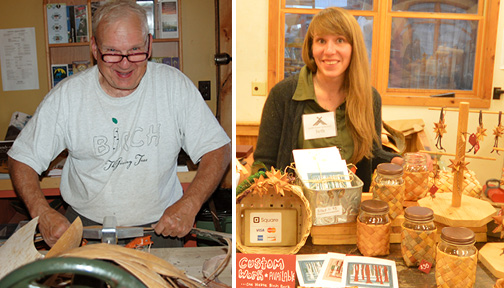
Catching Weaver Fever

Poke around most classrooms at North House, and you will find a bit of birch bark hiding in the corner. Whether in a wood box or in the hands of a student or craftsperson, it is an important and ubiquitous material here on campus. We asked John Zasada, a long time instructor here, and Beth Homa, a former intern and new instructor, to share some thoughts about their love of birch and teaching the art of weaving birch bark.
John Zasada was a student in the first birch bark class Charlie Mayo taught at North House. "If someone had told me in 1999, (I was 61 at the time), that I would be working with birch bark in 2015, I would have told them they were crazy!" John says. A former forester, he was inspired by Charlie to continue learning about tree anatomy in a new way. "Working with the bark was just sort of a natural thing to do once I was introduced to the material. I was as much interested in the structure and function of bark and management of birch forests as I was in weaving." John now teaches the Birch Bark Tutorial with Charlie and Julie Kean; he says that students benefit from seeing three different approaches to working with bark.
Beth Homa arrived at North House for the internship program in 2011, dreaming of boat building until a birch bark class with Charlie, John, and Fred Livesay changed her path. "I got the weaver fever!" she says. Entranced by the excitement of hunting for birch and the simplicity of working with hand tools, Beth was soon teaching birch bark craft weekly on the campus. Now a full time weaver, artist and teacher, Beth will teach her first day-long courses at North House this summer.
What has birch bark taught you?
JZ: As far as the weaving goes, I always think back to Charlie's saying: "If it's worth doing, it's worth doing poorly." In other words, it's as much about the process [as the product], and for me that includes finding and harvesting the bark, storing the bark, prepping the bark and making the basket.
BH: It's taught me to look at the persity of a single species. Some cultures have 20 different words for snow, and now I understand that. Harvesting birch bark is like unwrapping a present that tells a story, and you learn to pay attention to how something is the same but still has such perse variations.
Beth, what has been rewarding about teaching at North House and beyond?
BH: At North House, people seem to understand what craft is and why it's important that I'm working with my hands and hand tools. I'm trying to make it easy to understand how easy it is to make something durable and beautiful, and when people see the trees here, the harvesting, and the weaving, they understand better. I also teach with one of North House's partners, the American Swedish Institute in the Story Swap program. I work at the Wellstone School, which is all immigrant, English as a Second Language students - Somali, Hmong, Latino. When I brought them birch bark, they were so excited and started talking about their families and the weaving that was familiar to them. They had never seen birch bark before, but they understood weaving and basketry and were excited to learn about this new tree and material.
John, as birch bark becomes more scarce, have you changed the way you work?
JZ: I have started to work with other tree bark: aspen, ash, cedar, pine, willow, and a few others.They are very different than birch outer bark, but it has been both fun and frustrating trying to understand these barks.
What do you think the future of birch craft looks like?
BH: I'm always trying to learn other styles of basketry. I get asked to do a lot of commission work, and I'm selective about that so that I only make items that will be used, rather than sitting on a mantle. There are just not enough birch bark trees to sustain my craft. I harvest sustainably, where trees will be clear cut, but I'm also starting to harvest in new places. Birch bark won't disappear, but I think people also need to take care of our native trees.
JZ: Part of the future is tied up with how birch forests are managed; only recently has there been some concern about regenerating birch because of its wood value and for biopersity. Birch will never be eliminated but I don't think that we will ever see the large stands of almost pure birch that were present across Minnesota in the last century. I think that one has to think about all uses of the tree, gathering sap, collecting chaga, finding character wood, etc. and not get hung up only thinking about the outer bark. That thinking is much to narrow… every tree has a story and we all need to understand birch's story.